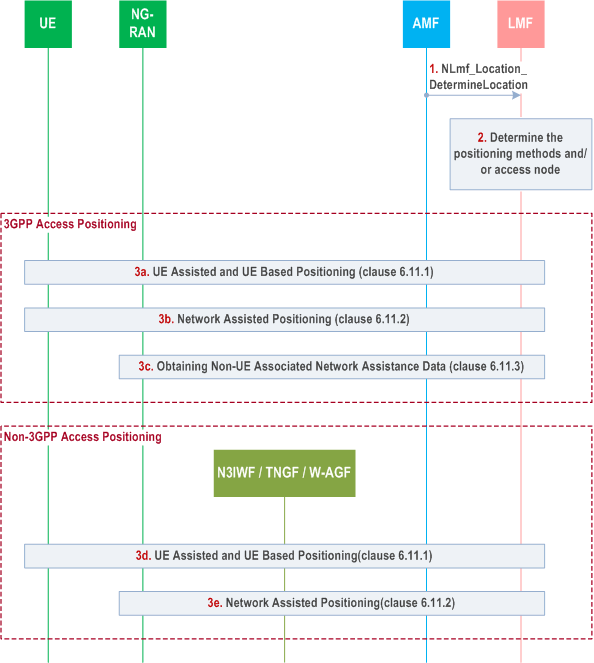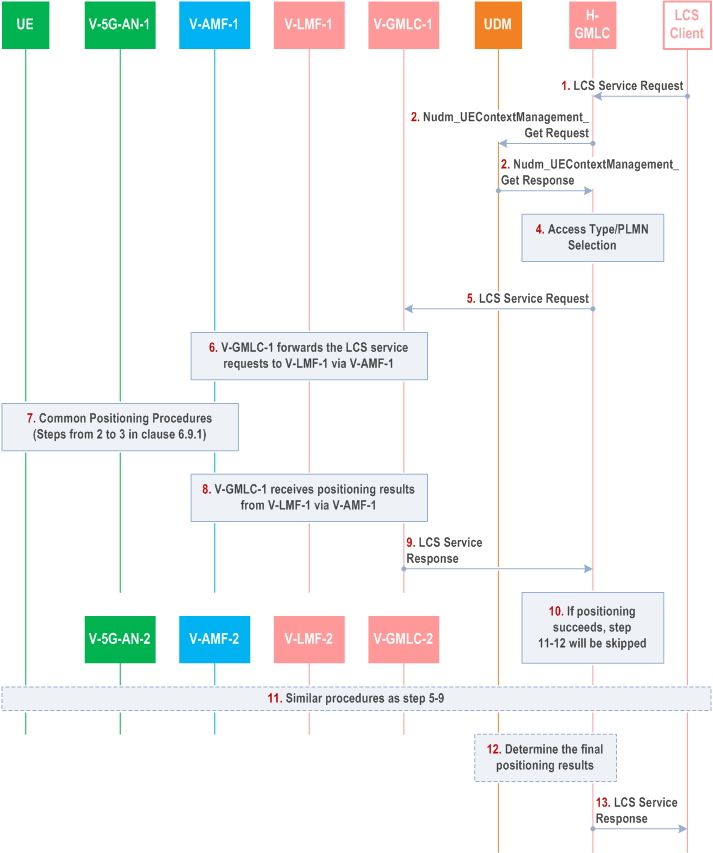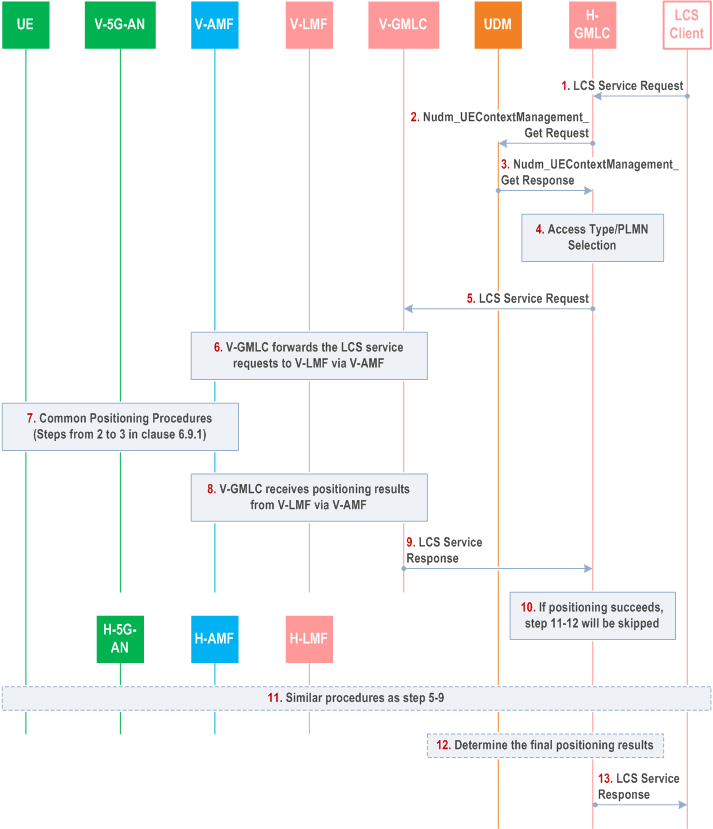Content for TS 23.273 Word version: 19.1.0
1…
4…
4.2…
4.2a…
4.3…
5…
5.5…
6…
6.1.2
6.1.3
6.1.4…
6.2
6.3…
6.3.2…
6.4
6.5…
6.7…
6.7.3
6.7.4
6.7.5
6.8
6.9…
6.10…
6.11…
6.12…
6.13…
6.14…
6.15…
6.16…
6.17…
6.18…
6.19…
6.19.2…
6.20…
6.20.4…
6.21…
7…
8…
A…
B…
C…
6.9 Procedures to Support Non-3GPP Access
6.9.1 Common Positioning Procedures when a UE is served by only one PLMN
6.9.2 MT-LR Procedures when a UE is served by Different PLMNs for 3GPP Access and Non-3GPP Access
6.9.3 MO-LR Procedures when UE is served by the Different PLMNs via 3GPP Access and Non-3GPP Access
6.9.4 NI-LR Procedures when a UE is served by Different PLMNs for 3GPP access and non-3GPP access
...
...
6.9 Procedures to Support Non-3GPP Access p. 97
6.9.1 Common Positioning Procedures when a UE is served by only one PLMN p. 97
Figure 6.9.1-1 shows the common positioning procedures to support location services with non-3GPP access when UE is served by only one PLMN, which provides either non-3GPP access only or both 3GPP access and non-3GPP access. The common positioning procedures can be triggered by:
- 5GC-NI-LR procedure (described in clause 6.10.1), which assumes that the serving AMF is aware of the emergency session initiation - e.g. due to supporting an Emergency Registration procedure or assisting in establishing an emergency PDU Session. If such emergency session procedure is initiated via non-3GPP access, the AMF provides access type to LMF in step 2 in clause 6.10.1,the LMF shall use the access type provided by AMF in step 2 in clause 6.9.1; or
- 5GC-MT-LR procedure (described in clause 6.1.1 and 6.1.2 and 6.10.2), which is applicable to a request from an LCS client for a current location.
-
5GC-MO-LR procedure (described in clause 6.2), for this case, the access type is selected by the UE using the UE Local Configuration to initiate MO-LR procedure which is the same as the 5GC-MO-LR Procedure in clause 6.2 with following differences:
- The AMF shall in step 4 of clause 6.2 include UE connectivity state per access type.
- In step 5 of clause 6.2 the modification in this clause shall be applied, the LMF shall also determine positioning methods and the positioning access type, which can be different with the access type selected by the UE.
- Deferred 5GC-MT-LR procedure for periodic, triggered and UE available location events (described in clause 6.3.1), which is applicable to report of location event for a deferred 5GC-MT-LR procedure.
- Unified Location Service Exposure Procedure (described in clause 6.5), which allows an NEF to provide location service exposure to an NF in HPLMN or to an external AF outside the HPLMN when requested by the NF or the AF.

Step 1.
The AMF invokes the Nlmf_Location_DetermineLocation service operation towards the LMF to request the current location of the UE, which includes the QoS requirement and UE connectivity state per access type.
Step 2.
The LMF determines the positioning access type and the positioning method based on the UE/network positioning capability, the QoS requirement and UE connectivity state per access type received from the AMF and the locally configured operator policy. The LMF may also determine the access type for transmission of an LPP message to the UE (e.g. in order to ensure the UE will be in a connected state for the selected positioning access type).
When the LPP protocol in TS 37.355 is determined to be used to obtain location information from the UE and the UE has both 3GPP and non-3GPP access, the AMF shall decide which access type should be used to transmit the location information if the LMF did not select an access type. For example, if the UE is in CM-IDLE state in 3GPP access and in CM-CONNECTED state in Non-3GPP access, AMF may prefer to select the N3IWF/TNGF/W-AGF to relay positioning signalling to UE, rather than performing paging procedures via the 3GPP access.
When the NRPPa protocol in TS 38.455 is determined to be used to obtain location information from the NG-RAN or N3IWF/TNGF/W-AGF:
Step 3a.
- In the case that 3GPP Access is determined to be used to transmit the location information, the Network Assisted Positioning procedure in step 3b and/or the obtaining Non-UE Associated Network Assistance Data procedure in step 3c shall be performed.
- In the case that non-3GPP Access is determined to be used to obtain the location information, the Network Assisted Positioning procedure in step 3e shall be performed.
- In the case that 3GPP Access is determined to be used to relay the location information, the UE Assisted and UE Based Positioning procedure in step 3a shall be performed.
- In the case that non-3GPP Access is determined to be used to relay the location information, the UE Assisted and UE Based Positioning procedure in step 3d shall be performed.
This step is same as the UE Assisted and UE Based Positioning procedure in clause 6.11.1.
Step 3b.
This step is same as the Network Assisted Positioning procedure in clause 6.11.2 with the difference that step 1 of clause 6.11.2 includes the selected Access Type (i.e. 3GPP access). The AMF forwards the Network Positioning message to the NG-RAN in step 3 of clause 6.11.2 based on the received Access Type.
Step 3c.
This step is same as the Obtaining Non-UE Associated Network Assistance Data procedure in clause 6.11.3.
Step 3d.
This step is same as the UE Assisted and UE Based Positioning procedure in clause 6.11.1 with the following difference:
Step 3e.
- The NG-RAN in clause 6.11.1 is replaced by the N3IWF/TNGF/W-AGF in Figure 6.9.1-1;
- Steps 2 and 5 in clause 6.11.1 are omitted;
- The location information returned by the UE can include information specified in clause 5.3.1.
This step is same as the Network Assisted Positioning procedure in clause 6.11.2 with the following difference:
- The NG-RAN in clause 6.11.2 is replaced by the N3IWF/TNGF/W-AGF in Figure 6.9.1-1;
- Steps 2 and 4 in clause 6.11.2 are omitted;
- The Access Type, i.e. non-3GPP access type, which is selected to provide the location information is included in step 1 of clause 6.11.2. The AMF forwards the Network Positioning message to the N3IWF/TNGF/W-AGF based on the received Access Type in step 1 of clause 6.11.2.
- The location information returned in step 5 of clause 6.11.2 is specified in clause 5.3.1.
6.9.2 MT-LR Procedures when a UE is served by Different PLMNs for 3GPP Access and Non-3GPP Access p. 99
Figure 6.9.2-1 and Figure 6.9.2-2 show the enhanced MT-LR positioning procedures to support location service with non-3GPP access when the UE is served by different PLMNs for 3GPP access and non-3GPP access. The procedures can be triggered by the 5GC-MT-LR Procedures described in clause 6.1.1, clause 6.1.2 and clause 6.3, which are applicable to a request from an LCS client for an immediate current location or a deferred location.

Step 1.
The step is same as step 1 in clause 6.1.1 or clause 6.3.1.
Step 2.
The step is same as step 2 in clause 6.1.1 or clause 6.3.1.
Step 3.
The step is same as step 3 in clause 6.1.1 or clause 6.3.1 with the difference that when the UE is served by more than one AMF the UDM provides to the HGMLC for each access type,
Step 4.
- serving AMF identity with the corresponding PLMN Id,
- possibly a VGMLC address.
When the HGMLC identifies that the UE is served by different PLMNs according to the returned information from the UDM in step 3 it may retrieve the CM state(s) per Access Type from the candidate AMFs by using Namf_EventExposure service, or from the UDM using Nudm_EventExposure service. The HGMLC selects one access type and its associated AMF based on the UDM returned information in step 3, QoS requirement, CM state(s) per Access type of the UE, PLMN identity and/or the locally configured operator policy.
Step 5.
The HGMLC forwards the location request to the VGMLC-1 and may include the V-AMF-1 identity received in step 3 and the target UE identity (e.g. SUPI).
Step 6.
The VGMLC-1 invokes the Namf_Location_ProvideLocation_Request service operation to forward the location request to the V-AMF-1. Then the V-LMF-1 receives the location request from the V-AMF-1.
Step 7.
This step is same as step 2-3 of the Common Positioning Procedures in clause 6.9.1.
Step 8-9.
The VGMLC-1 receive the location service response from the V-LMF-1 and for a request for an immediate location, returns positioning results to the HGMLC. For an immediate location, the location service response contains positioning information, the information about the positioning method used and the indication of whether the obtained location estimate satisfies the requested LCS QoS (e.g. accuracy) or not (described in clause 9.1.1 of TS 23.271). For a request for a deferred location, the location service response indicates whether the location request was accepted.
Step 10.
For a request for an immediate location, if the HGMLC identifies that the location service response from the chosen PLMN meets required LCS QoS, it returns the results to the LCS Client directly. Otherwise, the HGMLC may forward the location request to another AMF (in another PLMN) so as to obtain the positioning result which can meet required LCS QoS shown as step 11. For a request for a deferred location, if the HGMLC identifies that location service was accepted (by the chosen PLMN), it returns this indication to the LCS Client directly. Otherwise, the HGMLC may forward the location request to another AMF (in another PLMN).
Step 11.
This step obtains the immediate positioning information or requests a deferred location from another PLMN, the details are the same as steps 5-9.
Step 12-13.
The HGMLC returns a location service response to the LCS client. For a request for immediate location, if the positioning result from the other PLMN meets the QoS requirement, the HGMLC returns it to the LCS client. Otherwise, the HGMLC returns final location service response without including any positioning result. For a request for deferred location, if the result from the other PLMN indicates acceptance of the location request, the HGMLC returns this to the LCS client. Otherwise, the HGMLC returns a final location service response indicating failure of the deferred location request.

Figure 6.9.2-2 shows the MT-LR positioning procedures when the UE is served by the H-PLMN and a V-PLMN. The difference with procedures shown in Figure 6.9.2-1 is that the HGMLC interacts with AMF directly shown in step 11 of Figure 6.9.2-2 without involving VGMLC shown in step 11 of Figure 6.9.2-1. In scenarios where the HGMLC prioritizes location by the H-PLMN rather than V-PLMN at step 4, steps 5-9 may be replaced by step 11 and step 11 (when step 11 occurs) is then replaced by steps 5-9.
6.9.3 MO-LR Procedures when UE is served by the Different PLMNs via 3GPP Access and Non-3GPP Access p. 102
When UE is served by the different PLMNs via 3GPP access and Non-3GPP access, UE uses the UE Local Configuration to select the access to initiate MO-LR procedure which is the same as the 5GC-MO-LR Procedure in clause 6.2. If Non-3GPP access is selected, the following difference exists:
- The NG-RAN in 5GC-MO-LR Procedure in clause 6.2 is corresponding to the N3IWF/TNGF;
- Step 5 in 5GC-MO-LR Procedure in clause 6.2 is the same as step 3d or 3e in Common Positioning Procedure when UE is served by the same PLMN in clause 6.9.1.
6.9.4 NI-LR Procedures when a UE is served by Different PLMNs for 3GPP access and non-3GPP access p. 102
When UE is served by the different PLMNs via 3GPP access and non-3GPP access, the UE selects one access to register to the 5GC for emergency services as defined in TS 23.167, or request the establishment of a PDU Session related to an emergency session.
The NI-LR procedures are the same as the 5GC-NI-LR Procedure (described in clause 6.10.1) with the difference that:
- if the procedures are performed for non-3GPP access, NG-RAN in Figure 6.10.1-1 is replaced by an N3IWF/TNGF/W-AGF and the UE Positioning in step 3 in Figure 6.10.1-1 is performed according to steps 3d and 3e in Figure 6.9.1-1.
- In step 2 in 5GC-NI-LR Procedure in clause 6.10.1, AMF also provides access type to LMF. LMF shall use the access type provided by AMF for positioning. The UE is replaced by 5G-RG in the case of wireline access type.